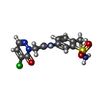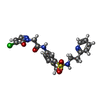+Search query
-Structure paper
| Title | Discovery of a First-in-Class Inhibitor of the PRMT5-Substrate Adaptor Interaction. |
|---|---|
| Journal, issue, pages | J Med Chem, Vol. 64, Issue 15, Page 11148-11168, Year 2021 |
| Publish date | Aug 12, 2021 |
 Authors Authors | David C McKinney / Brian J McMillan / Matthew J Ranaghan / Jamie A Moroco / Merissa Brousseau / Zachary Mullin-Bernstein / Meghan O'Keefe / Patrick McCarren / Michael F Mesleh / Kathleen M Mulvaney / Foxy Robinson / Ritu Singh / Besnik Bajrami / Florence F Wagner / Robert Hilgraf / Martin J Drysdale / Arthur J Campbell / Adam Skepner / David E Timm / Dale Porter / Virendar K Kaushik / William R Sellers / Alessandra Ianari /  |
| PubMed Abstract | PRMT5 and its substrate adaptor proteins (SAPs), pICln and Riok1, are synthetic lethal dependencies in MTAP-deleted cancer cells. SAPs share a conserved PRMT5 binding motif (PBM) which mediates ...PRMT5 and its substrate adaptor proteins (SAPs), pICln and Riok1, are synthetic lethal dependencies in MTAP-deleted cancer cells. SAPs share a conserved PRMT5 binding motif (PBM) which mediates binding to a surface of PRMT5 distal to the catalytic site. This interaction is required for methylation of several PRMT5 substrates, including histone and spliceosome complexes. We screened for small molecule inhibitors of the PRMT5-PBM interaction and validated a compound series which binds to the PRMT5-PBM interface and directly inhibits binding of SAPs. Mode of action studies revealed the formation of a covalent bond between a halogenated pyridazinone group and cysteine 278 of PRMT5. Optimization of the starting hit produced a lead compound, BRD0639, which engages the target in cells, disrupts PRMT5-RIOK1 complexes, and reduces substrate methylation. BRD0639 is a first-in-class PBM-competitive inhibitor that can support studies of PBM-dependent PRMT5 activities and the development of novel PRMT5 inhibitors that selectively target these functions. |
 External links External links |  J Med Chem / J Med Chem /  PubMed:34342224 / PubMed:34342224 /  PubMed Central PubMed Central |
| Methods | EM (single particle) / X-ray diffraction |
| Resolution | 1.88 - 2.39 Å |
| Structure data | EMDB-23609: PRMT5 bound to covalent PBM-site inhibitor BRD-6988  PDB-6v0p: |
| Chemicals |  ChemComp-QN4:  ChemComp-CL:  ChemComp-SFG:  ChemComp-GOL:  ChemComp-HOH:  ChemComp-YJG: |
| Source |
|
 Keywords Keywords | SPLICING/TRANSFERASE /  methyltransferase / methyltransferase /  splicing / SDMA / splicing / SDMA /  epigenetic / SPLICING-TRANSFERASE complex / TRANSFERASE/INHIBITOR / TRANSFERASE-INHIBITOR complex epigenetic / SPLICING-TRANSFERASE complex / TRANSFERASE/INHIBITOR / TRANSFERASE-INHIBITOR complex |
 Movie
Movie Controller
Controller Structure viewers
Structure viewers About Yorodumi Papers
About Yorodumi Papers






